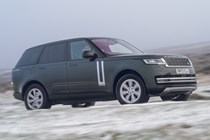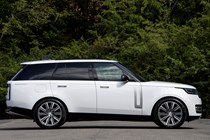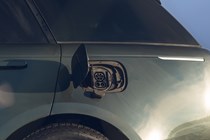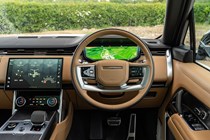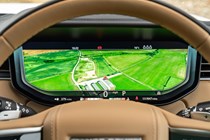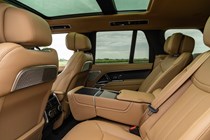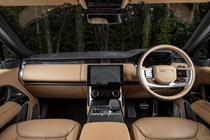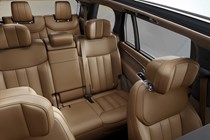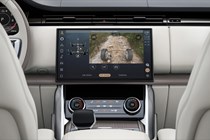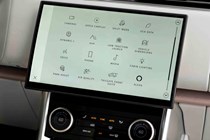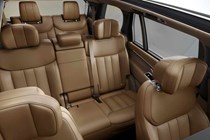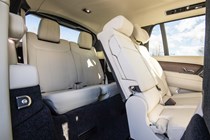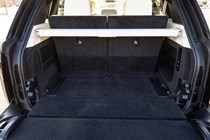
Range Rover engines, drive and performance
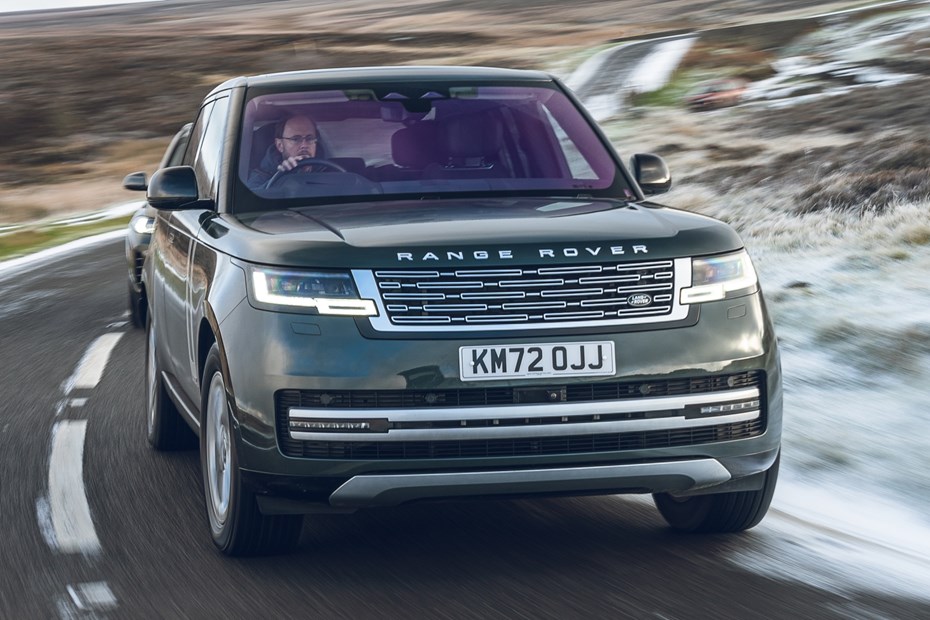
- Six drivetrains are available in total
- Two plug-in hybrids, electric to follow
- Excellent eight-speed auto and four-wheel drive
Petrol engines
The Range Rover petrol lineup is a simple one in lieu of high-performance SV versions that may follow in years to come. The entry-level model is the P360 petrol, which uses a 3.0-litre six-cylinder engine featuring mild hybrid technology to help with efficiency and improve fuel consumption. It develops 360hp, with a 400hp P400 also available. They’re quick enough with 0-62mph in around 6.0 seconds, yet need to be worked harder than the more effortless diesels.
Top of the line for petrols right now is the P530, which is muscular enough to deliver thumping performance in an effortless way. As the name implies, this BMW-sourced V8 power unit develops 530hp for safe overtaking and unstressed motorway driving. You’ll get from 0-62mph in 4.4 seconds and there’s much to like about it. It sounds good, pulling with a refined V8 gargle, and its hefty combination of torque and power serve to make the Range Rover feel lighter than it is.
All models regardless of fuel type are four-wheel drive and come with an eight-speed gearbox, with a low-range transfer ‘box for effective off-road ability. You get all of the Land Rover systems, too, such as dynamic air suspension, Terrain Response 2, and a 900mm wading depth. This ability might not be a priority for many Range Rover drivers, but it’s still an important part of the car’s DNA.
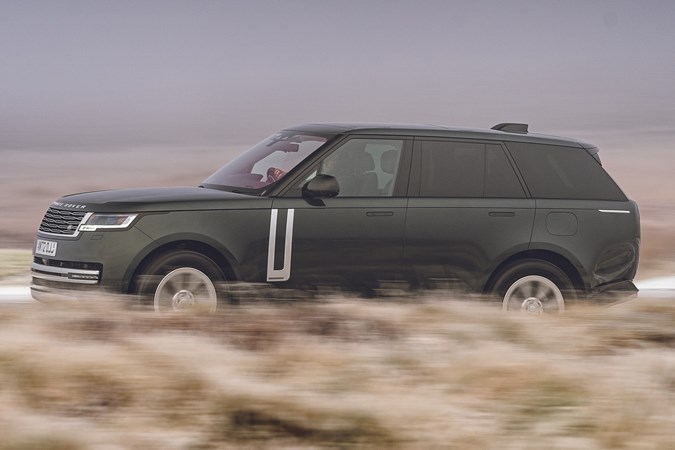
Diesel engines
Still important to Range Rover drivers, the option to choose from two diesel power units is a welcome one. Available in D250, D300 and D350 guise, they’re all powered by Land Rover’s 3.0-litre straight-six diesel. They’re effectively the same engine in three states of tune – 250hp, 300hp and, predictably, 350hp.
As you’d expect, the diesel engine is whisper quiet at all times, with little in the way of audible ‘chatter’ at idle. It pulls strongly from low revs and delivers excellent punch without needing to extend the engine or use Dynamic mode to wake up the automatic transmission. In many ways, this is the optimum Range Rover for those who travel long distances – it’s also the pick of the lineup for those who might want to use their car for heavy work or towing.
The D350 suits the car down to the ground. It’s barely any slower than the petrol on real roads, incredibly civilised for a diesel and lends the car a wonderfully laidback character. That it’s also more cost-effective both to buy and to run just adds to the appeal and makes it an easy favourite for us.
Hybrid engines
The plug-in hybrids are being marketed by Land Rover as ‘electric hybrid’ – pointing out that, with over 70 miles of all electric range (according to WLTP) they’re almost more of an electric car than they are a petrol.
We managed 42 miles on a near-freezing day (we’d expect significantly more in warmer temperatures), which is still on the high side – but it’s little wonder when you consider that the Range Rover’s battery is a mighty 38.2kWh. That’s slightly larger than the pack you get in some versions of the Hyundai Ioniq Electric…

You can get the hybrid engine in two flavours – P440e and the range-topping P510e. Performance is mighty whichever you go for – the P440e will do 0-62mph in just 6.0 seconds, and the P510e just 5.5 seconds. Considering the cars weigh nearly three tons, unladen, that’s impressive. Sadly performance isn’t anywhere near as sparkling in electric mode as the motor produces just 141hp. 2024 brings improved P460e and P550e models with a 218hp electric motor that should help greatly. We’ll update this review as soon as we’ve sampled them.
The remarkable thing is how effortlessly the car shuffles between its two power sources. The inline-six petrol engine is so quiet when it’s on that you actually have to look at the rev counter to figure out whether you’re running on petrol or the plug socket. It even sounds good when you rev it – something you couldn’t have said about the previous-generation car with its weedy four-cylinder engine.
What’s it like to drive?
- Hugely refined and comfortable
- Excellent body control in Dynamic mode
- Ride quality is very impressive
On the move it’s effortless, even at speed. You sit high, of course, with fantastic visibility. The steering isn’t as vague and light as before, with the precise, intuitively weighted system building confidence immediately. This is especially impressive given the new four-wheel steering system boosts agility and makes tight manoeuvres so much easier, yet doesn’t feel unnatural from behind the wheel.
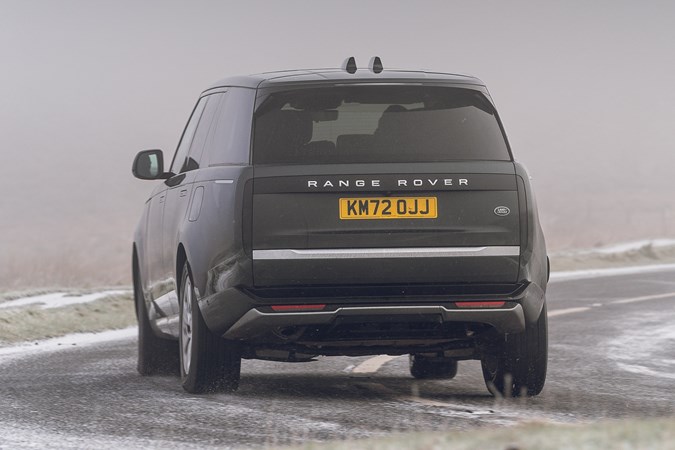
Despite lots of clever chassis tech, there is still some bodyroll in corners although it is very much in keeping with the traditional Range Rover feel. Grip levels are high, so it’s possible to comfortably carry plenty of speed down a B-road should you wish. Those after more thrills should look at a Porsche Cayenne or Bentley Bentayga, although cars fitted with the optional Dynamic Response Pro get adaptive anti-roll bars that reduce lean and boost agility.
Comfort should always be a Range Rover’s priority, and the new car doesn’t disappoint. It’s delightfully supple, ironing out the road’s surface incredibly well, especially at speed. Only the odd pothole will generate a bit of a thud, but it’s much less pronounced that in its predecessor or rivals such as the BMW X7 and Mercedes GLS. With very little wind, road or engine noise, it’s a truly excellent long-distance cruiser.
The four-wheel drive system is equally fluent on-road and off it, where its low-range ratios give the Range Rover the kind of loose-surface ability most rivals can only dream of. We tested out the four-wheel drive system on steep, rocky trails which, though not easy, barely scratched the surface of the car’s ability. Rivals would have surely floundered nonetheless, lacking as they do the Rangey’s formidable arsenal of off-road-ready systems.


